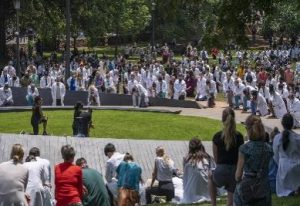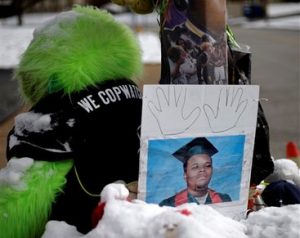2 Goals
Make explicit goals for improving the community or campus environment (e.g., promoting understanding, making all feel valued and safe, inspiring, commemorating) as a means to focus the initiative on the most pertinent symbols and public spaces. Combine these with a deeper approach to reaching these goals.
POSSIBLE STRATEGIES
Consider a wide array of potential community goals including, for example: make all feel welcomed and affirmed, announce or remind all members of their community’s aspirations, bring people together, increase mutual respect, help people remember, develop deeper conversations, advance social equity and correct other injustices, avoid sowing hate that might lead to targeting of individuals, demonstrate accountability for past harms (potentially including reparations), facilitate safe expression of emotions, teach history, promote free speech and assembly, assist people in understanding each other, inspire, and, especially on campuses, give people confidence that they can succeed.
Identify, preliminarily, the highest priority goals to help guide the process design.
Use the decision-making process developed later (Process Design) to adjust and further prioritize goals.
Communicate frequently with the community about the goals, as community members will trust the process and be more receptive to the results if they perceive that the planners have been transparent and embraced their own values and aspirations. Further, community members may offer ideas consistent with the goals. The goal setting may also spur community discussion about changes beyond environmental ones that might advance these goals.
IN MORE DETAIL
People are not always conscious of the effects of symbols and public spaces on themselves and even less so on others within their community or university. The goal-setting process can include listening and reflection that facilitates conscious and proactive planning of symbols. It makes sense to return to discussions and adjustment of the goals throughout the process.
Symbols recognize who we are as Americans.
Rev. Nelson B. Rivers, III, Pastor, Charity Missionary Baptist Church; Vice President, Religious Affairs and External Relations, National Action Network, who advocated for removal of the Confederate battle flag from the South Carolina statehouse for four decades.
Planners are likely to focus first on the goal of removing public symbols and spaces that offend, such as statues and reenactments associated with the Confederacy that remain in spaces frequented by the public. As the Supreme Court of Virginia recently recognized, a statue on public land “is a form of public speech.” The justices added, “This means that any symbolism associated with the [Robert E.] Lee Monument, whether its historical and social significance changes over time, is a message endorsed by the government.”[1]
Much can be gained if planners expand the focus to include other goals as well, as illustrated just below by the goal setting at the University of Virginia, in South Africa, and in a city in Northern Ireland. Of course, this discussion assumes for simplicity that the community goals will be positive in nature, but this has not always been the case historically. Planners need to be attentive to groups that may seek to aggrandize one group of people or to intimidate.
ILLUSTRATIONS
Goal-setting as a basis for the proactive planning process

The University of Virginia’s proactive initiative preceded the demonstrations in 2017 both in the city and on campus over removal of a statue of Confederate military commander Robert E. Lee from a park in Charlottesville. The formal campus planning began in 2013 with the appointment of the President’s Commission on Slavery and the University (PCSU), following six years of advocacy by a community-university coalition. The PCSU identified multiple goals including: create space that would allow for appreciation of a more complete history, promote learning about slavery and its legacy, host expression of emotions, bring people together, and allow for conversations that might lead to advancements in racial equity. The PCSU joined a student advocacy group in promoting a new memorial to the enslaved laborers. The design team led a lengthy and widespread community engagement process that developed six designs on three sites. Ultimately, the collaborative process led to the favorite site and favorite design. The Memorial to Enslaved Laborers opened in 2020.
Recognizing the breadth and internal tensions among goals for change
The City of Derry-Londonderry in Northern Ireland has been developing projects to create more shared spaces in circumstances of substantial and sometimes violent divisions between groups defined as Catholic/Irish and Protestant/British. Policies creating shared spaces have identified the symbolic importance of parts of the city to different communities and have included the building of the Peace Bridge over the River Foyle (2011) and the repurposing of the historic Ebrington Barracks. Much of this work was based upon principles identified by the ILEX consultancy group:
- “A physical space where people of all backgrounds can live, work, learn and play together.
- A ‘shared public space’ free from symbols or displays of aggression, threat or intimidation, whether real or perceived.
- Balancing the right to freedom of expression and assembly with rights to security, freedom of movement and to live free from fear and intimidation.
- A ‘shared public space’ fosters interactions that move beyond joint access to or use of a particular space that creates sustained connection and relationships between groups and individuals.
- A public space where diversity, cultural expression and difference can be expressed, tolerated and celebrated.
- A place marked by tolerance of genuine cultural diversity, where what have previously been antagonistic communal expressions become a non-antagonistic spectrum of individual identities which evolve through their interaction.”[2]
The planners acknowledged that they would sometimes have to weigh competing goals, such as to gather people across societal fault lines; offer freedom of expression, safety, and a welcoming experience; and celebrate cultural identities.
Deep Dive: Parkland, Florida & Ferguson, Missouri
When conflicts over public symbols arise, it can be helpful for leaders to clarify what they and their communities hope a symbol will accomplish—whether to honor, mourn, educate, provoke reflection, or inspire change. The cases from Parkland and Ferguson offer contrasting examples of how differing or undefined goals can lead to tension around memorials, even when the community shares a sense of collective loss.
Parkland: A 2018 school massacre in Parkland, Florida, left seventeen students and staff of Marjory Stoneman Douglas High School dead. In the immediate aftermath, the mourning community embraced opportunities to demonstrate solidarity and support. Less than 48 hours after the tragedy, seventeen white crosses were erected in Parkland’s Pine Trails Park to commemorate the lives lost. Over the course of the following six weeks, mounds of stuffed animals, signs, flowers, pictures, and handwritten notes filled the area. Many community members viewed the memorial as a way to keep the memories of deceased students and staff alive. However, public health and public safety concerns began to emerge, especially after the memorial was the site of accusations of theft and arrests.
In response to these concerns, community members gathered to dismantle the memorial. The local historical society opted to gather and store the memorial items at Florida Atlantic University until plans for a permanent memorial site were finalized. While the high school was eventually demolished, the Parkland 17 Memorial Foundation continues planning to erect a permanent fixture on a serene, 150-acre preserve that borders the two impacted communities, Parkland and Coral Springs.[3]
Ferguson: In 2014, Michael Brown, an 18-year-old Black man, was shot and killed by a police officer in Ferguson, Missouri.[4] Police and bystanders support different accounts of what transpired leading to Brown’s death. Nonetheless, “hands up, don’t shoot” became a rally cry for the Black Lives Matter movement that emerged.[5]

Brown’s lifeless body was left in the road for four hours, which some community members interpreted as a sign of disrespect.[6] Shortly thereafter, Brown was memorialized with stuffed animals and other mementos placed on the roadside at the location where Brown died. In September 2014, the memorial inexplicably burned down and was quickly rebuilt by community members. In December 2014, the memorial was destroyed by a car driving through the makeshift shrine. When asked about the incident, a Ferguson police spokesman responded that no crime had been reported and referred to the memorial as “a pile of trash.”[7]
In May 2015, after negotiations between the city and Brown’s family, the memorial was removed and deemed a safety hazard. Funding for a permanent plaque in its place was arranged by Brown’s family.[8] A city statement indicated that the memorial items would be stored by the National Urban League; however, it was later revealed that many of the perishable items were put directly in the trash.[9] Some community members did not feel that it was clearly communicated to them that public health concerns prevented moldy and otherwise hazardous items from being stored.
The contrasting responses to symbolic memorials in Parkland and Ferguson underscore how communities define—and sometimes struggle to agree on—the goals they seek to achieve through public symbols. Whether aiming to grieve, demand justice, inspire unity, or claim space, these cases reveal why clarifying symbolic goals is a critical early step in any process involving contested spaces.
- Taylor v. Northam, No. 210113, 2021 WL 3918940 (Va. Sept. 2, 2021) (unanimous). ↵
- ILEX, Derry City Council and North West Development Office, Research Study for the Creation of Shared Spaces within the City of Derry, Londonderry, Final Draft. ↵
- About Us, Parkland 17 Memorial Foundation, https://parkland17.org/about/. ↵
- “Department of Justice Report Regarding the Criminal Investigation into the Shooting Death of Michael Brown by Ferguson, Missouri Police Officer Darren Wilson,” Department of Justice, March 4, 2015, https://www.justice.gov/sites/default/files/opa/press-releases/attachments/2015/03/04/doj_report_on_shooting_of_michael_brown_1.pdf. ↵
- Cheryl Corley, “Whether History Or Hype, 'Hands Up, Don't Shoot' Endures,” NPR, August 8, 2015, https://www.npr.org/2015/08/08/430411141/whether-history-or-hype-hands-up-dont-shoot-endures. ↵
- Jim Salter, “Michael Brown’s death 10 years ago sparked change in Ferguson,” Associated Press, August 9, 2024, https://apnews.com/article/ferguson-protests-michael-brown-10-years-blm-88a3dd50044c89800f5bd0e300c27351. ↵
- Jose A. DelReal, “Michael Brown Memorial Destroyed Overnight,” The Washington Post, December 26, 2014, https://www.washingtonpost.com/news/post-nation/wp/2014/12/26/auto-draft/. ↵
- Trymaine Lee, “Iconic Michael Brown Memorial Torn Down,” MSNCB, May 20, 2015, https://www.msnbc.com/msnbc/iconic-michael-brown-memorial-torn-down-msna600081. ↵
- Jack Suntrup, “Michael Brown Memorial to be Replaced With Plaque,” NAACP, May 21, 2015, http://naacpms.org/michael-brown-memorial-to-be-replaced-with-plaque/. ↵
